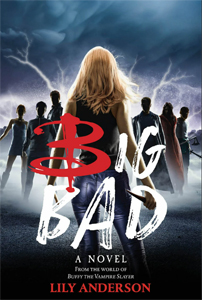“Big Bad: A Novel” (September 2022) announces up front that it’s set in an alternate “Demondale” in 1999. It’s obviously a fun novel from the outset, but I worried that it might be more “fun” (in style and premise only) than actual fun (a reading experience that makes me smile).
Lily Anderson’s debut Buffyverse book ends up being more of the latter – a light, easy read that smoothly presents the rules of neighboring realities and interdimensional travel and has a simple plot. “Big Bad” isn’t particularly substantial; it won’t stick with me and it doesn’t make me re-examine characters or themes.
But it’s written by someone who loves “Buffy,” and who is particularly attached to Anya and Jonathan, who trade off POV chapters. Others aren’t as “accurately” written, but this is an alternate reality, a fair outlet for writing familiar players in new ways. If Angelus never got a soul, he’d go on a different path. “If a butterfly flaps its wings,” and all that.

“Big Bad: A Novel” (2022)
Author: Lily Anderson
Series: “Buffy the Vampire Slayer”
Setting: Demondale (a neighboring Hell colony dimension of Sunnydale), 1999
Anderson perhaps doesn’t believe in destinies, as she’s not beholden to the established romantic pairings. Ultimately, this is refreshing. It makes a “soulmates”-obsessed reader (which I used to be, back in the day) expand their mind.
Buffy as a villain?
The only Original Universe character is Buffy herself. I wonder if Anderson initially aimed to write the Slayer’s chapters as villainous interludes, like how Golden and Holder used to write about ancient evils in italics. Anderson writes Buffy’s exploits in neighbor dimensions in somewhat awkward present tense, as if she’s trying to make it all about the goal and action. The Slayer must snuff out each dimension’s existence by finding its Black Flame flag — which marks it, like Demondale, as a Hell colony.
Indeed, the Hell-colony versions of Sunnydale are like stages in a video game, where Buffy fights through lackeys to get to an end boss guarding the Black Flame flag. But don’t fear, “Big Bad” is not like “reading” a video game. Anderson’s fight scenes are short and sweet – most likely because they are not her strength, but give her credit for knowing that.
Anderson can’t resist making Buffy a warm character, like when the Slayer sees an alternate version of her mom and wishes she were back home in Sunnydale. The idea of Buffy as the titular Big Bad (from the perspective of Demondale residents) never quite clicks, even with a wink.
Focus on the outsiders
Alterna-Anya and Alterna-Jonathan, though, give us insights into the Sunnydale versions. Not because Anderson plays with opposites or paths-not-taken, but because she gets into their heads “before” their coming-of-age (so to speak) events in Sunnydale. There aren’t many underexplored main characters, but these two almost qualify because they are usually used for comedy, or broad explorations of outsider-ness, or as a foil for other characters.

In “Big Bad,” Anya is separated from the marnoxon gem (bluntly named after the writer of “The Wish”) — the power source for her Wish-granting necklace pendant. And Jonathan is separated from Warren, whom he accidentally kills with a malfunctioning freeze ray. Anya and Jonathan reflect on who they are and what they want out of life, and they cross paths in a rather sweet arc about friendship.
Because Anya and Jonathan are the foundational heart of “Big Bad,” it allows room for the “fun” stuff to truly be fun – for the most part. Certainly, Anderson leans more toward the comedic “Buffy” stylings that became prevalent by the time Anya joined the cast and Jonathan became a Big (well, little) Bad. But that’s fair, and references to the Trio’s action-figure obsession and Anya’s past acts of vengeance aren’t overdone.
In fact, “Big Bad’s” darkness is underdone. As with the other three novels since Disney acquired the license, this is pitched as young-adult. Granted, Giles (going by “Ripper” in Demondale) and Spike say “shit” way more than seems right, and the book is not free of violence or disgusting demon habits by any means. Plus, Darla’s intimate relationship with The Master borders on risqué.
‘The Wish,’ but lighter
Anderson could double down on horrific possible outcomes like “The Wish” does, but in the end the only human characters who bite the dust are evil ones. And even the bad guys we like aren’t in much danger. Angelus, the proprietor of The Bronze, is more likely to dust his bartop than to be dusted.
Whenever an alterna-story puts evil in power, it’s neat to think about how that makes the world different, and Anderson touches on this concept. The Mayor is Anderson’s best-written supporting character. He Ascended and successfully placed a sunshade over Sunnydale to create Demondale to start the 1999 calendar year.
Although this isn’t a stark “Escape from New York” dystopia, we do get a sense of Demondale’s socio-economics as the author taps into the Buffyverse’s gradual softening of the notion of a “demon.” Some are evil, others are simply different. Anderson doesn’t go full bore into this situation – such a conundrum for Slayers who are taught to view all demons as evil – but she does set her story in such a world. This is the somewhat jokey version of the Buffyverse, but it is what the shows’ writers made it, so Anderson is playing fair.
“Big Bad” wraps with a “to be continued” (if readers really want it to), but one go-around in Demondale is enough for me. Certainly, I prefer Sunnydale (as I’m supposed to), and at the same time, “Big Bad” doesn’t have the tragic vibes of “The Wish.” Nor does Anderson aim for the absurdity of Jonathan’s world in “Superstar.”
I wouldn’t want to live in Demondale, but I had a good time visiting it.
Click here for an index of all of John’s “Buffy” and “Angel” reviews.

